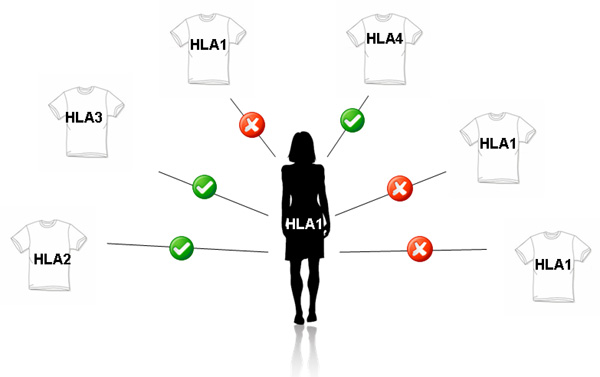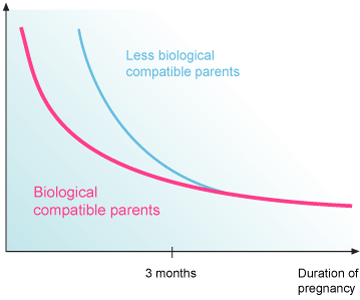The Science behind Genepartner
Inspiration
The GenePartner project was inspired by a famous study performed by Prof. Dr. Wedekind at the University of Bern in Switzerland. In this study, Prof. Dr. Wedekind recruited female volunteers to smell T-shirts worn by men for three consecutive days and rate them for attractiveness. He then analyzed the particular part of DNA that codes for HLA (human leukocyte antigen) molecules and found that women preferred T-shirts from men whose HLA molecules were most different from their own. Sensing and classifying the HLA genes is something our bodies do automatically and subconsciously.

 HLA genes and the immune system HLA molecules play a central role in controlling the activation of immunological effectors during an immune response and are therefore essential for immune resistance. A greater variety in HLA genes offers a greater variety in possible immune responses. In terms of evolution, this makes perfect sense: children of couples with a higher variety in their HLA genes (and hence, immune responses) will have better protection from a greater variety of diseases. Simply put, this means that their body has more weapons to use in its defence against a disease. An important additional effect is that comparing HLA genes can help identify kinship and prevent potential inbreeding.
HLA genes and the immune system HLA molecules play a central role in controlling the activation of immunological effectors during an immune response and are therefore essential for immune resistance. A greater variety in HLA genes offers a greater variety in possible immune responses. In terms of evolution, this makes perfect sense: children of couples with a higher variety in their HLA genes (and hence, immune responses) will have better protection from a greater variety of diseases. Simply put, this means that their body has more weapons to use in its defence against a disease. An important additional effect is that comparing HLA genes can help identify kinship and prevent potential inbreeding.
The GenePartner formula
In 2003, the GenePartner team decided to take this discovery one step further and see if there are specific patterns of HLA genes that “attract” each other more. We tested a large number of individuals (both romantically involved couples and persons not in a relationship) for their HLA genes. The results were astounding and led to the development of a formula that combines the diversity factor studied by Prof. Dr. Wedekind, together with several other evolutionary factors researched and developed by the Swiss Institute for Behavioral Genetics.
The GenePartner formula measures the genetic compatibility between two individuals and makes an accurate prediction of the strength of their basis for a long-lasting and fulfilling romantic relationship.
Genetic compatibility
High diversity in specific immune system components ensures greater resistance against a variety of diseases. Our bodies automatically sense how diverse the immune systems of people around us are, and we subconsciously classify them depending on how genetically compatible they are to our own.
With genetically highly compatible people we feel that rare sensation of perfect chemistry. This is the body’s receptive and welcoming response when immune systems harmonise and fit together.
The effects of genetic compatibility
Genetic compatibility results in an increased likelihood of forming an enduring and successful relationship. Research has also shown that the sex lives of genetically compatible partners are more satisfying than average. Additionally, fertility rates are higher in genetically compatible couples and they have healthier children.
Scientific Publications
- Wedekind C., Seebeck T., Bettens F. And Paepke A.J. "MHC-dependent mate preferences in humans", Proc.R.Soc.Lond.B 1995 260:245-249.
- Wedekind C, Chapuisat M, Macas E, Rülicke T. 1996 "Non-random fertilization in mice correlates with the MHC and something else." Heredity. 77 ( Pt 4):400-9.
- Wedekind C, Penn D. 2000 "MHC genes, body odours, and odour preferences." Nephrol Dial Transplant. 15(9):1269-71
- Jacob S.,McClitock M.K., Zelano B. and Ober C. "Paternally inherited HLA alleles are associated with woman's choice of male odour", Nat Genetics 2002, 30:175-179.
- Garver-Apgar C.E., Gangestad S.W., Thornill R., Miller R.D. and Olp J.J. "Major histocompatibility complex alleles, sexual responsivity, and unfaithfulness in romantic couples", Psychol Sci 2006, 17(10): 830-835.
- Wedekind C., Seebeck T., Bettens F. And Paepke A.J. "MHC-dependent mate preferences in humans", Proc.R.Soc.Lond.B 1995 260:245-249.
- Garver-Apgar C.E., Gangestad S.W., Thornill R., Miller R.D. and Olp J.J. "Major histocompatibility complex alleles, sexual responsivity, and unfaithfulness in romantic couples", Psychol Sci 2006, 17(10): 830-835.
- Kenney AM, Evans RL, Dewsbury DA. 1977. Postimplantation pregnancy disruption in Microtus ochrogaster, Microtus pennsylvanicus, and Peromyscus maniculatus. Journal of Reproduction and Fertility 49: 365-367.
- Bruce HM.1959. An exteroceptive block to pregnancy in the mouse. Nature 184: 105.
- Thompson RN, McMillon R, Napier A, Wekesa KS.2007. Pregnancy block by MHC class I peptides is mediated via the production of inositol 1,4,5-trisphosphate in the mouse vomeronasal organ. : J Exp Biol. 210(Pt 8):1406-12
- Jacob S.,McClitock M.K., Zelano B. and Ober C. "Paternally inherited HLA alleles are associated with woman's choice of male odour", Nat Genetics 2002, 30:175-179.
